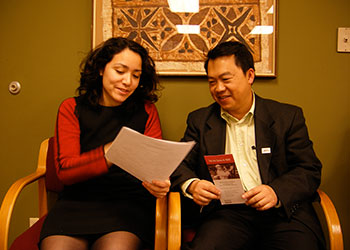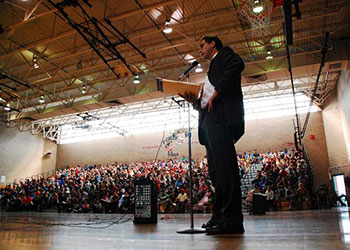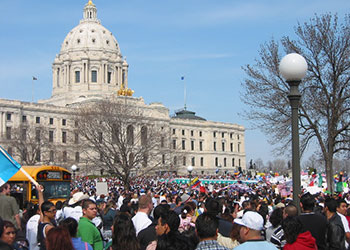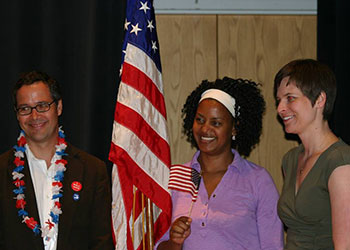News > Immigration In Minnesota
Making Minnesota Welcoming: How Local Immigration Policies Work
Posted on Dec 20 2018
 City and state governments are taking the lead in welcoming and protecting immigrants and refugees. Though immigration law is federal, state and local jurisdictions can take strong stands to protect and welcome immigrants and refugees. That’s happening across the country, and across Minnesota. Some of the ways that Minnesota communities welcome and protect immigrants and refugees include providing legal representation for residents facing deportation hearings, “welcoming city” resolutions, city separation ordinances, electing immigrant-supporting candidates for local office, and more.
City and state governments are taking the lead in welcoming and protecting immigrants and refugees. Though immigration law is federal, state and local jurisdictions can take strong stands to protect and welcome immigrants and refugees. That’s happening across the country, and across Minnesota. Some of the ways that Minnesota communities welcome and protect immigrants and refugees include providing legal representation for residents facing deportation hearings, “welcoming city” resolutions, city separation ordinances, electing immigrant-supporting candidates for local office, and more.
Defending Immigrants and Refugees
During 2018, the city of St. Paul and both Hennepin and Ramsey Counties set up immigrant defense funds. These funds will provide attorneys for residents who are in deportation proceedings.
If someone is charged with a crime, and faces the possibility of even one day in jail, they have a right to a public defender. If an immigrant faces possible deportation from the country where they have lived for 25 years, they do not have a right to a public defender. In immigration courts, there are no public defenders. Immigration law and courts are extremely complicated. Immigrants who are represented by attorneys are more likely to be released from detention, to appear at all their court hearings, and ultimately are up to ten times more likely to win their cases.
Minneapolis has established an Office of Immigrant and Refugee Affairs to serve immigrant and refugee residents in Minneapolis. Attorney Michelle Rivero heads the office. Minneapolis also provides other services, such as know-your-rights presentations and training for volunteers to staff an immigration detention hotline.
St. Paul will hire a full-time attorney in the city attorney’s office with a focus on immigration. City Attorney John Choi said that the immigration attorney will advise on charging, so that prosecutors can avoid charging in ways that trigger deportation proceedings.
“We’re not taking about cases with killers or rapists, but probationary-type offenses,” he said. “So these are cases where a U.S. citizen would get probation, but someone who doesn’t have that status would get convicted of the same charge and suffer a very harsh collateral consequence.”
The new attorney will also assist with expungements and U Visa cases.
Especially in today’s climate of stepped-up raids, arrests, and deportations, legal representation for immigrants is crucial. But that’s not the only, or the first step that Minnesota cities and counties have taken to protect and welcome immigrants and refugees.
Separation Ordinances: The First Step
Some 15 years ago, Minneapolis adopted an “immigration separation” ordinance. Chapter 19 of the municipal code provides that city employees “shall only solicit immigration information or inquire about information status when specifically required to do so by law or program guidelines as a condition of eligibility for the service sought.” Public safety officers are similarly limited to “Investigate and inquire about immigration status when relevant to the potential or actual prosecution of the case or when immigration status is an element of the crime.”
Minneapolis Mayor R.T. Rybak explained in 2007:
“The role of the police officer is to protect and to serve every person who is in Minneapolis. We know that if there is a fear that reporting something to the police could jeopardize someone’s immigration status, including those that have legal status, then people will not come forward with the information that we need to know. We need people to report domestic abuse, we need them to report gang activity. We have seen many cases where people are afraid to come forward for fear that it will jeopardize their immigration status, even if they are legal immigrants.”
St. Paul followed suit a year later, with the City Council unanimously adopting a separation ordinance in April 2004.
These are the ordinances that Trump and his administration commonly denounce as “sanctuary cities.” In 2017, St. Paul Mayor Chris Coleman clarified what the separation ordinances do and do not mean:
“City of Saint Paul employees are not immigration officials. I want to be very clear about what the law is — and has been since 2004 — in Saint Paul. Chapter 44 of the City’s Administrative Code is entitled “Employee Authority in Immigration Matters” and is understood as a separation ordinance. Cities call these “separation ordinances” to emphasize the separate role of local law enforcement from federal immigration enforcement. While I would encourage everyone to read it for themselves, the fundamental provisions of the chapter are the following:
- The City works cooperatively with the DHS, as it does with all state and federal agencies, but the City does not operate DHS programs for the purpose of enforcing federal immigration laws.
- It is the policy of the City that all residents are equally entitled to protection and that all residents should be able to access City services to which they are entitled, without regard to their immigration status under federal law.
- Public safety personnel may assist federal law enforcement officers in the investigation of criminal activity involving individuals present in the United States who may also be in violation of federal civil immigration laws.
“In plain language:
“The City of Saint Paul wants all its residents to feel comfortable seeking out City services — including law enforcement — when they are in need. We want everyone to call the police when they are the victim of or witness to a crime without fear they will be asked about their immigration status. We want everyone to call the paramedics in a medical emergency, enroll their children in after-school programs or use our library services. Our staff — including our police officers — will not ask for proof of immigration status. Period.”
While Trump and his administration denounce sanctuary cities as havens for criminals, it is clear from these descriptions that is not the case. Minneapolis and St. Paul enforce state laws, but refuse to hunt down undocumented immigrants who are peacefully living and working here. Instead, they support law enforcement by promising not to inquire about immigration status when people seek city services or are victims of or witnesses to crimes.
That does not stop ICE from operating inside the cities: Minneapolis and St. Paul have no control over ICE.
Sheriffs, Jails, and Police
Minneapolis and St. Paul city governments do not control the Hennepin County and Ramsey County sheriffs, who run the jails in these jurisdictions. Outgoing Hennepin County Sheriff Rich Stanek fully cooperated with ICE, furnishing names of immigrants, release times, and access to the jail to ICE officers. That became a major issue in the 2018 election, and Stanek was defeated by Dave “Hutch” Hutchinson, who promised to end collaboration with ICE.
“John Keller, executive director of the Immigrant Law Center of Minnesota, which offers legal representation to county residents facing deportation, said “the willingness of immigrant victims to trust police … just got a whole lot better because of this election.”
“There is a very stark difference between the two candidates,” he said. “The positive focus on doing public safety instead of doing civil immigration collaboration, I think is an extremely important change of culture.”
In Minneapolis, Mayor Jacob Frey announced in October 2018 that all squad cars will have a “Know-Your-ICE-Rights” placard, in both English and Spanish.
The city policy is clear, despite resistance from some individual police officers and the head of the police union.
Welcoming Cities
Across the state, Minnesota communities have adopted “welcoming cities” resolutions, often in response to small but vocal anti-immigrant groups. When one St. Cloud city council member began talking about banning refugees, the city council responded with a 5-1 vote for a welcoming resolution.
“I think it’s important to show people this one guy bringing forward a resolution is not the voice of the City Council or the voice of the people of our community,” [City Council member Jeff] Goerger said prior to the meeting. “The mayor has been asking for the council to take some action. I feel it was my place to put my thoughts on paper and bring it forward.”…
“Goerger’s resolution states “St. Cloud is welcoming to all residents without regard to age, gender, sexual orientation, socio-economic status, race, ethnicity, religion or country of origin, and we renew our commitment to foster a community in which all people have the right to pursue life, liberty and happiness.”
Willmar and St. Joseph also passed welcoming resolutions in 2018, with Hutchinson voting down a welcoming resolution. Austin, Winona, and Minneapolis are listed on the Welcoming America website, and Rochester has long been a welcoming city with its own Welcome Center for immigrants and refugees.
Besides formal welcoming resolutions, local government bodies pass specific resolutions, such as the December Minneapolis City Council resolution opposing the Federal government’s policies restricting the ability to seek asylum in the US and reaffirming the city’s support of immigrants or the August Hennepin County Board direction to staff to ask federal immigration agents to behave better while on county property.
Northfield became the first city in Minnesota to issue municipal IDs to residents, including undocumented immigrants in July.
Minneapolis approved a municipal ID program in December, a move characterized by the Star Tribune as “a smart policy that will help more immigrant residents conduct business and fully participate in the city’s economy and civic life.”
Welcome/Not Welcome
Despite the efforts described above, immigrants and refugees face prejudice and danger in Minnesota, as well as in the rest of the country. The 2018 electoral campaign’s anti-immigrant rhetoric and ads provided many examples of that prejudice. So do actions by local law enforcement in many jurisdictions, and the increasing number of hate crimes, reported and unreported.
Nonetheless, communities across Minnesota show that local action can make a positive difference for immigrants and refugees—and that’s good for all of us.




